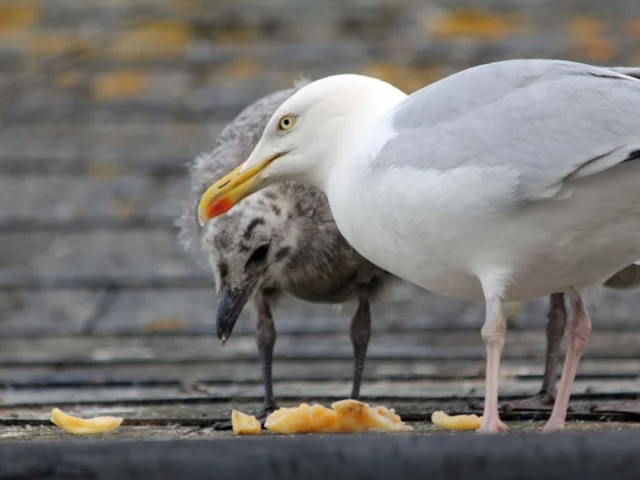Removing food access may help to control 'nuisance' gulls
a1007ecd-1b25-432e-893c-3f143f4c4b61

Scientists have reported that making waste food supplies less accessible may be more effective at countering urban gull problems than removing rooftop nesting.
The Dutch researchers, writing in the journal Bird Study, and based at an ecological consultancy firm in Oud-Vossemeer and the Institute of Environmental Biology, Utrecht University, studied a colony of gulls in The Hague in 2014. By tracking colour-ringed gulls throughout the study area, the researchers were able to monitor numbers and behaviour during different phases of the breeding cycle.
Conflicts between gulls and humans are a particular problem in seaside towns, with noise, defecation, aggression and destruction of rubbish bags all highlighted as problems. The increase in urban breeding colonies in The Netherlands is thought to be due to increased predication of the gulls in their natural breeding grounds by Foxes.
Many previous studies have focused on urban nesting locations and gull behaviour around landfill sites, but this is one of the first large-scale studies to investigate the use of cities by gulls in traditional breeding colonies and their contribution to these ‘nuisance events’.
As expected, the number of gulls observed decreased during the laying and incubation periods, and peaked post-hatching, coinciding with an increase in the number of so-called ‘nuisance events’. These events were defined by the researchers as any incident where more than 25 gulls interacted with a human activity (such as a garden party or around food waste) for a period of more than 15 minutes.
The Hague is a coastal city in The Netherlands where large species such as Lesser Black-backed and Herring Gulls are considered to be a pest. The researchers tracked gulls tagged with coloured rings for a six-month period, often moving around the city on their bicycles and observing and logging the gulls with binoculars or cameras with a telephoto lens.
They found that of the 49 nuisance events observed involving the colour-ringed gulls, only four were in the laying and early incubation periods; furthermore, the majority of these nuisance events occurred where rubbish was available. The researchers concluded that making the source of food less available during the key two months of the breeding season, such as by storing it underground, should be effective in preventing the majority of gull-human conflicts.
Naomi Huig, one of the authors of the study, commented: "The issue about gull nuisance is a recurring topic in press and politics that divides opinions in several coastal cities. There is, however, a lot of misunderstanding about this problem.
"The peak of the problem is limited to two months in summer. The most important conclusion of this paper is that controlling rooftop-breeding gulls is not the solution to prevent nuisance. As long as food is available, gulls will be attracted to urban areas from elsewhere. Practical solutions that limit food availability especially in the summer months can be very effective in the prevention of nuisance if applied thoroughly.”
The Dutch researchers, writing in the journal Bird Study, and based at an ecological consultancy firm in Oud-Vossemeer and the Institute of Environmental Biology, Utrecht University, studied a colony of gulls in The Hague in 2014. By tracking colour-ringed gulls throughout the study area, the researchers were able to monitor numbers and behaviour during different phases of the breeding cycle.
Conflicts between gulls and humans are a particular problem in seaside towns, with noise, defecation, aggression and destruction of rubbish bags all highlighted as problems. The increase in urban breeding colonies in The Netherlands is thought to be due to increased predication of the gulls in their natural breeding grounds by Foxes.
Many previous studies have focused on urban nesting locations and gull behaviour around landfill sites, but this is one of the first large-scale studies to investigate the use of cities by gulls in traditional breeding colonies and their contribution to these ‘nuisance events’.
As expected, the number of gulls observed decreased during the laying and incubation periods, and peaked post-hatching, coinciding with an increase in the number of so-called ‘nuisance events’. These events were defined by the researchers as any incident where more than 25 gulls interacted with a human activity (such as a garden party or around food waste) for a period of more than 15 minutes.
The Hague is a coastal city in The Netherlands where large species such as Lesser Black-backed and Herring Gulls are considered to be a pest. The researchers tracked gulls tagged with coloured rings for a six-month period, often moving around the city on their bicycles and observing and logging the gulls with binoculars or cameras with a telephoto lens.
They found that of the 49 nuisance events observed involving the colour-ringed gulls, only four were in the laying and early incubation periods; furthermore, the majority of these nuisance events occurred where rubbish was available. The researchers concluded that making the source of food less available during the key two months of the breeding season, such as by storing it underground, should be effective in preventing the majority of gull-human conflicts.
Naomi Huig, one of the authors of the study, commented: "The issue about gull nuisance is a recurring topic in press and politics that divides opinions in several coastal cities. There is, however, a lot of misunderstanding about this problem.
"The peak of the problem is limited to two months in summer. The most important conclusion of this paper is that controlling rooftop-breeding gulls is not the solution to prevent nuisance. As long as food is available, gulls will be attracted to urban areas from elsewhere. Practical solutions that limit food availability especially in the summer months can be very effective in the prevention of nuisance if applied thoroughly.”

